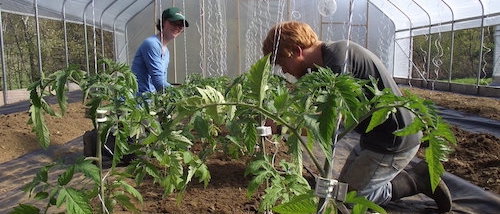Make the most of your effort as well as space and time
Space and time. Anyone who has formed a basic crop plan knows that these two dimensions dictate what you can grow within your farm or garden. The third and sometimes overlooked dimension is effort. If space and time determine what you can grow, effort informs what (and how) you should grow.
Farmers with an eye for efficiency will be able to get the job done with minimal wasted effort, saving precious resources and protecting their bodies from unnecessary wear and tear. These small efficiencies can make the difference between a motivated, poised farmer and a burnt out, begrudged farmer.
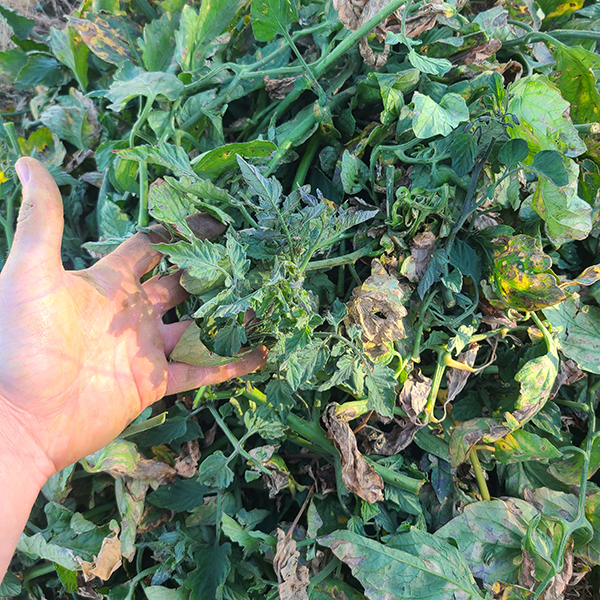 This bed is harvested out and ready for in-place composting. All images courtesy of the author.
This bed is harvested out and ready for in-place composting. All images courtesy of the author.
Effort was an important planning point on our 1/3-acre intensive market garden, especially regarding bed turnover. To be financially sustainable we had four to five plantings per bed, per year. Turning a finished (possibly weedy) cropped-out bed back into a fully prepped plant-ready bed required high efficiency. This was the imperative for using in-place composting whenever possible.
In-place composting (IPC) can efficiently terminate a crop, prep a bed for planting, and create a stale seeded bed to reduce weeds — all while reducing labor, space, and resources spent on a traditional compost pile.
What is IPC?
In-place composting is exactly what it sounds like. Instead of cutting or pulling out old crop residue and hauling it to a traditional compost pile, we would simply leave the residue in the field to decompose. There are many avenues for bed prep that fall under this simple definition (traditional tilling-in, deep compost mulch system, and occultation), but we found that using a flail mower, shallow soil disturbance, and a silage tarp worked best in our context.
To use IPC, first mow crop residue with a flail mower to increase surface area and speed up decomposition. We used a BCS 749 walk-behind tractor for all of our bed prep. In lieu of a flail mower, you could use a regular lawn mower, but it won’t chop the residue as finely, and it could possibly bog down and spit unwanted debris on neighboring beds. The goal is to chop the residue into as fine of a mulch as possible to reduce decomposition time.
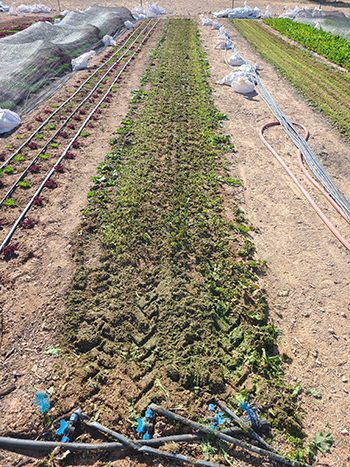 This is what a bed looks like after flail mowing. A flail mower is preferred since the goal is to chop the residue into as fine of a mulch as possible to reduce decomposition time.
This is what a bed looks like after flail mowing. A flail mower is preferred since the goal is to chop the residue into as fine of a mulch as possible to reduce decomposition time.
After mowing, add any desired amendments to the soil surface and broadfork them in if needed. Then, power harrow the bed at a 2- to 3-inch depth to disturb the plant roots, evenly incorporate applied amendments, and create a smooth, fully-prepped bed. You could use an oscillating hoe and a bed roller if you don’t have a power harrow, but that’s far more labor intensive. An added benefit of using the power harrow is that it leaves clear bed edges behind at exactly 30 inches, which helps with seeding/transplant spacing.
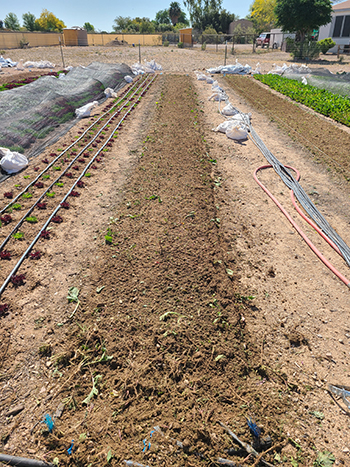
What the bed looks like after shallowly power harrowing. An added benefit of using the power harrow is that it leaves clear bed edges behind which helps with seeding and transplant spacing.
Finally, place a silage tarp on the bed to smother potential weed seeds and speed up decomposition even more. You can use woven landscape plastic here, but this material allows more air exchange, possibly resulting in slower decomposition times. The goal here is to create a warm, dark environment that encourages decomposition and exhausts the previous crop’s stored energy to prevent regrowth. Place sandbags (Dewitt is our preferred brand) or weights of some kind every 5-10 feet along the edges of the tarp. Cover for about a week in the hot months and 3-4 weeks in the cold months, black side up. After your waiting period, untarp and behold your good work… then get to planting.
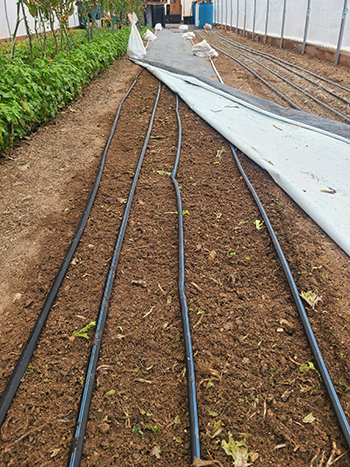
An IPC bed after tarping, for as little as a week in the summer or up to 4 weeks in colder parts of the year.
It should be noted that a simpler, more time-consuming method of IPC is to only tarp the crop and let nature do the rest (i.e., occultation). This is a tried and true method, but on a small scale where three to four extra weeks of decomposition time could be the difference between getting four croppings per bed, per year versus six croppings, it made more sense in our context to use the flail mower and power harrow.
Crop-specific IPC considerations
Here’s the skinny on how to IPC typical crops in a mixed-vegetable farm. Cut greens like arugula, herbs, spinach, or salad mix that have been densely seeded are prime candidates for IPC. They’re a pain to cut or pull out by hand and they terminate easily under the tarp.
One small efficiency is that if the majority of the vegetative matter has already been harvested and there are only a couple of inches of plant stubs, you could possibly skip the flail mower step. However, this will not disrupt the roots and possibly increase the time required for termination.
Long-term crops such as tomatoes, squash, broccoli, or kale that grow thick stems and lots of foliage are good for IPC — with a couple of small caveats. With these hardier crops, it’s best to cut the stems of the plants an inch below the soil surface to ensure they don’t grow back. If you have the time to leave the tarp on for a couple extra weeks, there’s no need to cut the stems.
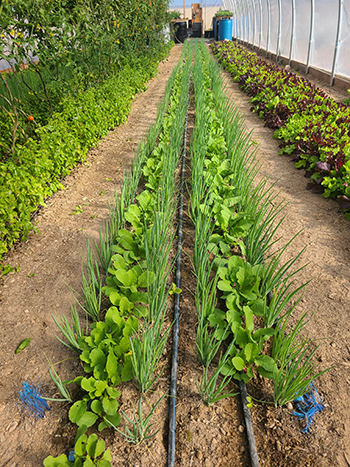
A bed that has been composted in place and re-planted.
Also, these crops may require a second or even third pass with the flail mower (depending on how good of a machine you have or how robust the residue is at time of mowing) to create that nice, shredded mulch that’s best for decomposition.
Roots like carrots, beets, or scallions are not ideal candidates for IPC. Since root beds are easy to clear out when harvesting, and have a tendency to grow back even after being mowed and tarped, it’s likely easier to skip IPC. For these beds, simply harvest out the remaining plants to have a clear bed to plant into and add the vegetative material to a bed that is scheduled for IPC. If the root bed is overgrown with weeds and it’s more efficient to IPC the bed, go for it. Just remember that some roots have a tendency to grow back if they aren’t tarped for long enough.
Multi-cut lettuce heads like Salanova lettuce fall into a bit of a grey area when deciding whether or not to IPC. We transplanted this crop and found it was relatively easy to terminate with IPC, but it was just as easy to treat it like a root bed and simply twist out the heads and throw them on a future IPC bed.
For our 50-foot beds that had low weed pressure, we usually preferred to remove the crops by hand instead of dragging out the BCS tractor and tarps. Since the ultimate goal of IPC is to efficiently flip a bed for the next planting, your context determines what best fits your farm.
As stated above, certain crops aren’t worth IPC. But what to do with that valuable organic matter? Again, simply pull that material and either place it on a bed that is ready for IPC or create a small staging area where the material can be temporarily kept while you wait for a bed to throw it on. The same goes for any prunings from crops like tomatoes or cucumbers. In an intensive market garden system, it’s rarely more than two weeks before a bed opens up.
Planting into IPC beds
When the beds are uncovered, everything should be decomposed to a point where you rarely need to rake any debris off the bed surface; just uncover and seed or transplant. At this point, disturb the soil surface as little as possible since the bed has essentially been stale seed bedded. If there is chunky debris leftover on the bed surface, leave the debris and use the double-disc opener attachment for the Jang seeder to avoid disturbing the soil surface more than needed.
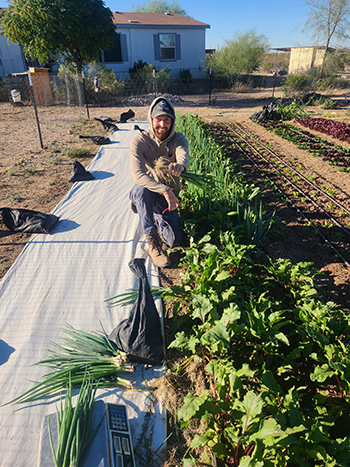
The author harvesting. Note the beds in various stages of in-place composting.
One side note: we liked to cover newly seeded beds with a silage tarp (white side up in the warm months, black side up in the cold months) in order to improve germination and weed control. Having the tarp next to the bed from its recent IPC made for a very efficient seeding protocol.
Tips for success
Cut your tarps to cover the pathways on both sides of the bed you’re covering. This will aid in full crop termination and stunt or kill weeds that have built up in the pathways.
Crop plan ahead of time to have neighboring IPC beds. If there are two or three beds next to each other scheduled for IPC, you need fewer tarps and sandbags or weights to perform the task. We had varying tarps cut to cover one to six beds at a time since we also used IPC when doing a quick-turn summer cover crop across the entire farm.
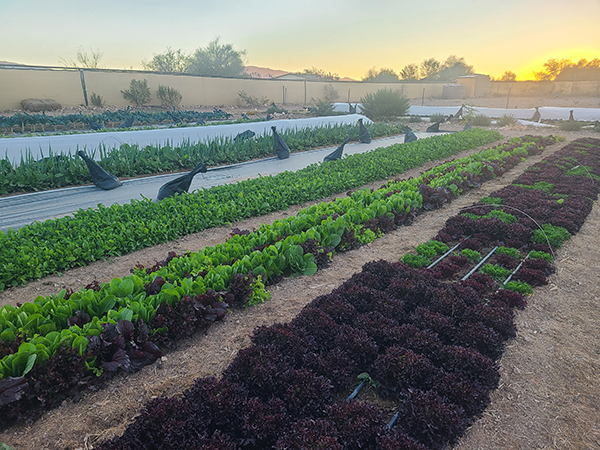
The author’s farm in Arizona, with beds in various stages of cropping and in-place composting, showing how IPC can be used to quickly flip an individual bed without disturbing the other beds around it.
This may be obvious, but when direct seeding beds, be sure to seed within the 30-inch width of the power harrow. If plants are seeded wider than the power harrow, you’ll need to do two passes on a bed in order to disturb their roots and get good crop termination.
Use survey whiskers to mark bed corners (Google them, they’re worth it). It’s much easier to flail mow and move tarps on and off beds when there isn’t rebar or pieces of wood sticking up at each bed corner.
Efficiency = longevity
As farmers and gardeners know well, we are always working within the constraints of time and space. IPC has proven incredibly useful in our intensive market garden where time and space were under additional pressure to generate financial returns on just 1/3 acre. Beyond that, it reduces burden, which maybe we don’t consider as often as we should. Turning over beds with IPC avoids hauling plant material back and forth around the farm, which decreases the stress we put on our bodies in a very physical occupation. Hopefully this method helps improve efficiency, increase profitability, and keep farmers a little more motivated in the process.
Tommie Burch was the Owner/Operator of Moonlighter Farm in Tucson, AZ. Having recently sold the farm, he is currently exploring the country with his dog and contemplating where his next farm will be! His passions are small-scale farming and ag education, give him a shout if you know of a good opportunity: [email protected] (Instagram @moonlighterfarm).
